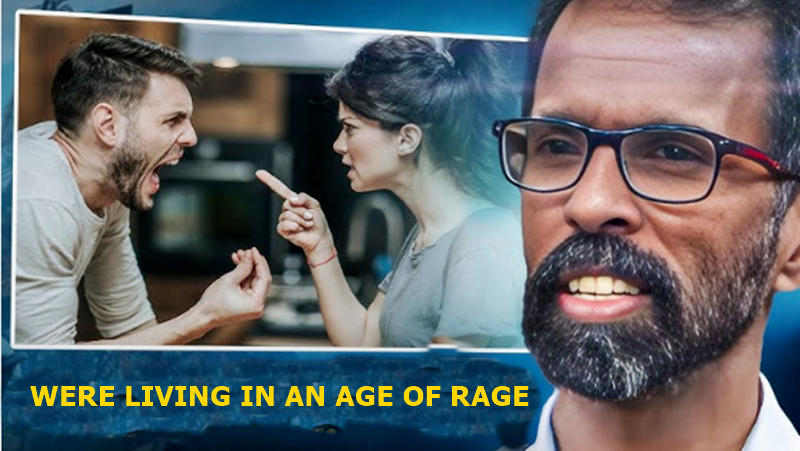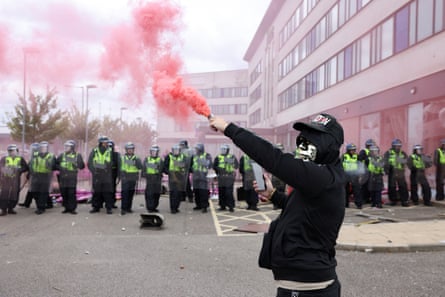We’re living in the age of rage. I’m a psychoanalyst – here’s what we need to do to calm down

By Guardian - Josh Cohen Sun 15 Sep 2024 08.00 BST
Anger has come to define the public mood – felt in the posts of social media warriors and harnessed by populist agitators such as Trump and Farage. But why are we so mad, and how can we learn to redirect our feelings?
Every morning, my inbox heaves with a new tranche of email alerts from Nextdoor, the social networking service for neighbourhoods where people in the area post recommendations, inquiries, requests, offers, information. The tone can be chummy, jocular, kindly, anxious, but mostly the posts are angry.
They include vituperative warnings about dodgy tradesmen; outraged reports of cruelty to animals witnessed by neighbours; snatches of grainy Ring camera footage purporting to show actual or attempted burglaries; complaints of junkies splayed on park benches and of predatory lone men approaching young girls; reports of vandalism, fly-tipping, charity muggers, phone scammers, poor restaurant service and late-night noise.
My heart sinks at each new set of notifications, festooned with rage emojis and opprobrium for lowlifes, SCUM, animals! Yet I’ve never been tempted to unsubscribe – and not only because the service is also a surprising showcase for human solidarity, reuniting desperate owners with their cats and wallets, offering help and advice to the hungry and infirm.
Much as I appreciate these outbreaks of decency, it’s the rage that continues to draw me. A batch of Nextdoor updates is a live window on the vexations of modern urban living, an electric chorus of sighs, growls and screams from the frontline of everyday reality.
The anger on Nextdoor strikes me as different in quality from the triumphal rage that characterises so much content on X, where it can seem as though disagreement can be voiced only in tones of righteous indignation and caustic sarcasm. This is why I stay off the platform; I can’t look at it without being struck by the trolling, shaming and piling on, the atmosphere of free-form hate and fury.
The social media giants foster the grandiose illusion that your smartphone is a global megaphone, blasting out your furious convictions on the social, ethical and geopolitical dilemmas of the moment to a potential audience of millions (even if your actual followers number in the low hundreds). It cultivates a mode of anger that is both impersonal and self-important, a style of sloganising that is grindingly repetitive, each post an echo of the last.

The anger voiced in Nextdoor posts seems endearingly human in contrast. Posts will reach (and likely interest) only those in your own neighbourhood, meaning there is less incentive to engage in performative provocation. Posters speak of wanting to vomit, to scream, to cry, to punch their thieving, fly-tipping, noisy tormentors. They remind us that anger, like all significant feelings, is experienced first at a bodily level, as a pressure towards discharge through the mouth or limbs.
In his 2006 book, Rage and Time, the German philosopher Peter Sloterdijk makes a distinction between two kinds of rage that casts some light on the mood and colour of our own moment. The first kind, which Sloterdijk calls “banked” rage, refers to the rage gathered and directed by popular, sometimes revolutionary leaders who achieved power by harnessing and “banking” the rage of the “humiliated and offended” victims of injustice and oppression across generations.
Such leaders seek to gather a mass of anger into a “rage bank”, a reservoir of emotional and political capital that could power a long-term transformation of society for better or worse.
For the populist agitator, the aim seems to be to stoke a rage for which there can be no relief
“Dispersed” rage, in contrast, lacks a sense of shared project or leadership, of a common understanding of what is wrong and how to put it right. The feeling of dispersed rage is intrinsically frustrating, insofar as it provokes bodily and psychic agitation which it can’t remedy. In this state of mind, we may feel injured or mistreated but can identify neither the source of the injury nor the cure. It’s from this agitated zone of feeling, I suspect, that so many Nextdoor users speak.
Recent events suggest that this raw and undirected kind of anger is prone to manipulation and exploitation, not least by X warriors. The recent riots after the stabbings at a children’s dance class in Southport were largely triggered by online demagogues and provocateurs who spread the false rumour that the suspect, in reality a 17-year-old boy named Axel Rudakubana born in Cardiff to Rwandan parents, was a Muslim immigrant named “Ali al Shakati”.
The former GB News presenter Laurence Fox said the incident was evidence that “We need to permanently remove Islam from Great Britain”, while Nigel Farage, more lethally artful than the pedlars of blatant lies and calumnies, asked whether “the truth” – that the incident was really terror-related – “was being withheld from us”.
Fox will have been fully aware that his objective of the permanent removal of Islam from the UK was as impracticable as it was dehumanising, just as Farage knew that his idle speculations offered no focus or direction for the anger of their intended addressees. For the populist agitator, the aim seems to be not to identify a real injustice and set out the appropriate relief but, on the contrary, to stoke a rage for which there can be no relief, to induce a kind of permanent mass enervation.
Doesn’t this come close to describing the mood of our time? For at least the past decade, and perhaps especially since 2016, with its flashpoints of the Brexit vote and Donald Trump’s election victory, anger has felt like the defining emotional texture of our daily social and political lives, giving rise to a pervasive atmosphere of mutual fear, suspicion and accusation, in which any perception of difference – cultural, ideological, racial, sexual, class – shades quickly into the assumption of enmity.
This public mood has seeped into our private lives and relationships. At the most immediate level, we can point to the well-documented divisions and resentments that Trump, Brexit, Covid restrictions, “the boats”, Gaza and so many other markers of cultural and political alignment have insinuated into the lives of families, friends, couples and communities.
In my psychoanalytic consulting room, irritable talk of these sources of division runs alongside more slippery emanations of anger, perceptible in one person’s clipped diction and flared nostrils, in another’s stiff, tightly guarded comportment on the couch, in still another’s coiled, withholding silence.
In her work on psychosomatic disturbances such as addictions and eating disorders, the psychoanalyst Joyce McDougall observed that such patients seem unable to experience feelings. Instead, they are “constantly engaged in immediately dispersing in action” whatever affects them emotionally. Rather than find images or words for their feelings of emptiness and isolation, they discharge their distress in the quick fixes of “medication, food, tobacco, alcohol, opiates and… frantic sexual exploits”.
When nervousness and insecurity become the dominant mood of a society, anger is given licence to spread and grow
McDougall wrote this during the 1980s. The symptoms she was ascribing to relatively circumscribed groups have spread exponentially wider with the advent of the internet and social media. To those compulsions she lists, all of which ultimately exacerbate the feelings of despair they seek to relieve, we can add the permanent itch of provocation and reaction on social media platforms.
Then there are the general conditions of what we might call malign public care: governments and other political actors that manipulate information, democratic institutions and class differences to foment division, fear and mistrust – between “native” citizens and migrants, leavers and remainers, red and blue states, workers and shirkers;
internet and TV news media that distort, deny and invent facts in order to stoke the rage of their viewers and listeners; big tech corporations that place us under permanent surveillance and harness our private data to direct our private lives. The psychosomatic patient McDougall describes as “feeling empty, misunderstood” starts to sound eerily like any of us. An angry society starts to seem almost inevitable.

When nervousness and insecurity become the dominant mood of a society, anger is given licence to spread and grow. Mistrust has become a dominant feature of our everyday lives, as we find ourselves trapped in informational bubbles, in which disagreement and difference breed not curiosity and exchange but antagonism and mutual cancellation from inside an echo-chamber.
It’s from this soil that the grandiose anger of social media warriors grows; the anger of countless virtual citizens trying to cancel out their own felt vulnerabilities and doubts, to brandish a clarity and certainty they crave but can never really achieve.
What makes the anger that drove Brexit and the election of Trump, or Russia’s war on Ukraine, or the current devastating conflict in Israel and Palestine, if not its dogged commitment never to question or examine itself? We assume we’re right so as to evade the risks of others’ – or even our own – curiosity, questions or uncertainty.
It is essential in this context to distinguish anger from aggression, as well as to acknowledge how easily the one shades into the other. Where aggression involves the impulsion to act, to impose oneself on people and things, anger is a feeling. The neuroscientist and philosopher Antonio Damasio distinguishes feelings from emotions, defining the latter as automatic stimulus responses, like freezing in fear or retching in disgust.
Feelings are a way of mapping these reactive responses to produce images and ideas about them. Feelings creatively process what emotions respond to blindly, facilitating what Damasio calls “the possibility of creating novel, non-stereotypical responses”. Anger, in this perspective, is of a higher order than aggression, a transformation of reactive behaviour into a kind of self-reflection.
But anger doesn’t always feel like a triumph of reflective feeling over reactive aggression. There is, after all, a certain satisfaction in the coupling of anger and aggression. Anger sharpens our sense of clarity and righteousness in taking action, whether that means a physical attack, a street protest or a marital row.
The uncoupling of anger from aggression often has the opposite effect. It deprives us of an immediate outlet for action, leaving us with an unrelieved pressure on our nervous system. I’m so angry, we often say, I don’t know what to do with myself. At which point, anger can take us down many different paths. It can lead us to the raw frustration of suppressed rage, or to presenting our anger in the guise of some other attitude (exaggerated politeness, over-friendliness, moroseness). It can also induce us to repress it, to cut ourselves off from the anger we’re feeling.
One of the most basic premises of psychoanalysis, known as transference, is that the patient’s relationship to the analyst is repeating a much older pattern of relating. Clinical work tries to bring the patient to awareness of this tendency, without which they’re likely to perpetuate this repetition instead of resolving it.
In transference, the analyst will come to be experienced, sometimes consciously, more often not, as an avatar of key figures from earlier stages of life: a parent, a teacher, a sibling, a friend, a lover, a colleague or a composite of two or more of these.
“You’ll end up totally fed up with me, just like every other man I meet,” a patient may tell me, or “That’s exactly the kind of snarky thing my father would say!” Transference often arouses unruly intensities of feeling in a patient, rendering the analyst an object of love, hate, trust, mistrust, fear, comfort, reverence or contempt, sometimes within a single session.
Underlying these feelings is a profound sense of dependency, derived from the earliest period of life, when our very survival depended on the ministrations of our carers. The basic scenario of psychoanalysis is fraught with power and all its attendant anxieties; a person brings the most vulnerable and hidden region of their psyche and places it in the care of the analyst, in the hope that this gesture of trust won’t be abused or exploited.
But the anxiety implied in this hope can never be fully dispelled. What if their show of benignity is a subtly disguised form of control and manipulation? Thought about this way, the risks of the psychoanalytic relationship bear a striking resemblance to the risks of the relationship between citizens and rulers.
erosion of trust in politicians is, we might say, transferential. Citizens are saying, in effect, “if we put ourselves in your hands and trust you to look after our best interests, you’ll only betray us”. It’s this kind of wariness that oils the wheels of the demagogue’s ascent.
The Italian psychoanalyst Massimo Recalcati suggests that in our age of moral chaos and loss of meaning, the younger generation are not so much managing the desire to kill and replace their fathers – as the classical idea of the oedipal complex suggests – than the urgent need for an absent parent to return and restore order and justice.
Recalcati calls this the “Telemachus complex”, referencing the son of Odysseus, who in The Odyssey must endure and hold off the attacks of the menacing Proci invading and usurping his family home, while searching over the horizon for his father to return and right these wrongs.
Doesn’t this state of mind capture precisely the nature of the anger animating the younger generation of climate protesters? Their demand isn’t expressing an urge to kill and usurp the older generation, but a desperate cry across the horizon to the parents who have gone quiet or missing while their planetary home has been violated or ransacked. The anger, embodied for us in the stern ferocity of Greta Thunberg, is directed not towards disposing of the parents but bringing them back to where they are most needed.
Where young climate protesters are using the transference to serve the interests of social and political justice, rightwing populism manipulates the transference to erode autonomy of mind and promote a parody of justice. Trump and Farage take the trust and belief their followers place in them, and their rage against traditional politicians, not to restore justice but to keep their constituencies in a state of permanent anger.
Trump’s long campaign of election denial sustains a mass rage that can’t be assuaged. For Trump, anger is the political gift that keeps on giving; his task is to keep it flowing. To achieve redress would risk switching off the tap.
What might happen if we didn’t default to automatic rage at the point we felt personally or politically provoked, if our debate relied less on a repertory of predictable stimulus responses? Some may argue that it would make way for the restoration of a political culture impelled by fact-based reason and the best interests of its citizens.
But after Brexit and Trump, it has become clear that the appeal to facts and best interests is an inadequate basis on which to resist far-right populism. Perhaps it is not so much the rational appeal to facts we need to be making so much as contact with the depth and complexity of our feelings.
The politics of “Stop the boats!” and “Build the wall!” feeds off a reactive, defensive rage. Lurking under that coiled anger is a rich and complex seam of emotional experience. Perhaps it is time we started listening to this teeming life of feeling, instead of to the noisy slogans drowning it out.

Author Josh Cohen
Josh Cohen is a psychoanalyst and emeritus professor of English at Goldsmiths, University of London. His book All the Rage: Why Anger Drives the World is published on 10 October by Granta (£16.99). To support the Guardian and Observer order your copy at guardianbookshop.com. Delivery charges may apply.
